About sighting and adjusting fire on the ships of the 2nd Pacific Squadron
Introduction
In connection with the ongoing disputes regarding the assessment of the artillery preparation of the 2nd Pacific Squadron, this article prepared a study of the method of sighting and adjusting fire on the ships of the 2nd Pacific Squadron.
To get a general idea of the organization of firing on the ships of the 2nd Pacific Squadron, the author recommends that you first read the article Tsushima. Accuracy Factors of Russian Artillery.
In connection with the extremely emotional and contradictory statements about the artillery preparation of the 2nd Pacific Squadron in narrative sources, most of this article is based on more reliable documentary materials, primarily orders and circulars.
However, relying solely on orders and circulars, it is impossible to get a complete picture.
The fact is that the shooting technique in the documents of the 2nd Pacific Squadron was never fully described, only some features or “weak points” identified during training firing were indicated.
Moreover, this technique has evolved, and therefore an attempt to assemble a puzzle from all available orders and circulars is obviously doomed to failure.
The fact that the manuals never published a complete shooting technique suggests that there was some basic principle known to the gunners of the 2nd Pacific Squadron, which was not necessary to repeat.
A careful acquaintance with the contents of the artillery orders and circulars of the 2nd Pacific Squadron allows us to assert that the shooting technique used by the Training Artillery Detachment was taken as the basis.
And this is not surprising: the flagship gunner of the squadron, Colonel F. A. Bersenev, before moving to a new position, was the head of training for quartermasters and gunners in the Training Artillery Detachment.
Methods of zeroing in and adjusting the fire of the Artillery Training Detachment
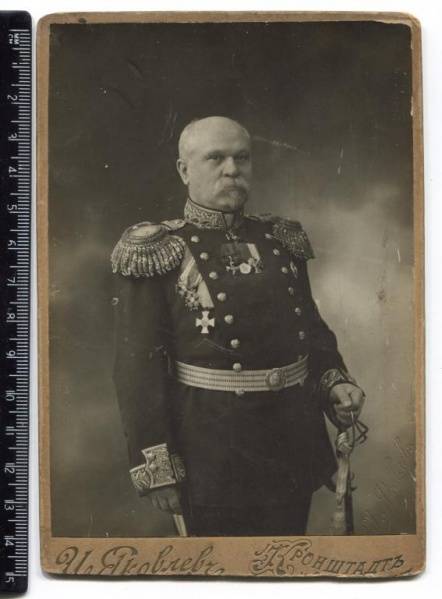
A. E. Shpynev
A textbook on artillery for students of the gunnery class of the Baltic Artillery Unit will help us get acquainted with this technique. fleet.
This book was published with changes and additions in 1896, 1900 and 1904. Its author is A.E. Shpynev, since 1902 the chief artilleryman of the Kronstadt port, and before that he was the head of training for gunners in the Training Artillery Detachment.
Now let's consider the very method of sighting and adjusting the fire, set out in the 1904 edition.
Do not rely solely on the accuracy of rangefinder measurements. To ensure the accuracy of the fire, the range and the rear sight correction must be specified by zeroing.
In order to better see the falling shells, cast-iron shells should be used.
When firing on land, the “fork” principle was applied, i.e., observing the result of the fall of the first projectile, the next shot was fired with such an amendment that it fell from the opposite side of the target.
Thus, the target was taken into a "wide fork", in other words, it turned out to be between the falling shells.
The third shot was fired at an average setting between the first and second, and the fourth shot was fired at an average setting between those closest to the target.
A "narrow fork" was obtained if the difference between the settings of the two shots that fell closest to the target did not exceed 3-4 divisions of the sight. In this case, it is already possible to open fire from all guns with rapid fire or volleys according to the average data of these shots.
When firing at sea, sighting had to be carried out in the same way as on land, but its completion should be the fall of a shell close in front of the enemy ship (if it was approaching). Accordingly, at the moment of opening fire, the enemy had to be in the middle of the projectile dispersion ellipse.
Next was to observe the results of the shooting. If the number of undershoots exceeds the number of flights, then it is necessary to increase the range, if vice versa, then reduce it.
Methods of sighting of the 2nd Pacific squadron according to the "Organization of the artillery service"
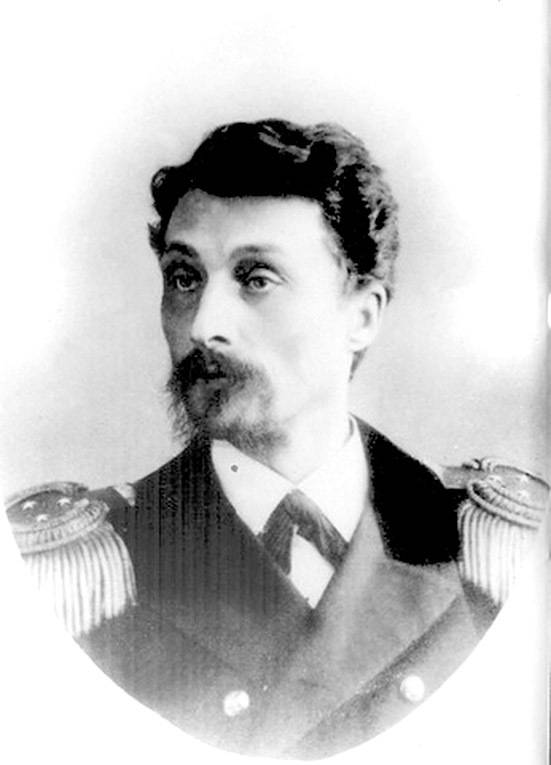
A. F. Bersenev
Initially, the firing technique was set out by A.F. Bersenev in a separate document “Organization of artillery service on ships of the 2nd squadron of the Pacific Fleet”, approved by order No. 5 of 8.07.1904/XNUMX/XNUMX.
"Organization of the artillery service" indicated the need for shooting if the battle began at long distances. The purpose of zeroing is to determine as accurately as possible the moment of opening rapid fire from all guns.
The organization of the sighting was assigned to the fire manager - a senior artillery officer. He had to indicate the plutong, which starts zeroing, based on the readings of the rangefinder, calculate the distance data and rear sight corrections for undershoot and transfer them to the guns.
Further, it was required to make sighting shots and, observing the falling shells, change the rear sight corrections to clarify the direction to the target, while, if possible, without changing the range. The enemy ship itself had to approach the distance at which sighting shots were fired.
When the projectile fell directly in front of the target, it was necessary to complete the sighting and open fire to kill.
In squadron combat, fire must be concentrated on the first number of the enemy battle line. The ship that started zeroing in had to show the distance and the setting of the sight, so that those following it could use this data instead of zeroing in.
As we can see, in the “Organization of the Artillery Service”, in comparison with the textbook on artillery for students of the class of gunners of the Training Artillery Detachment of the Baltic Fleet, a simplified methodology was adopted.
"Fork" was not required, apparently, out of the hope of being able to accurately determine the distance with the latest rangefinders, which were equipped with the 2nd Pacific Squadron.
Artillery preparation in Reval
In August-September 1904, the squadron in Reval began intensive artillery training. From the experience gained, some changes were made to the zeroing technique.
Firstly, the question arose of the difference between the falls of their shells.
Circular No. 330 of 18.09.1904/XNUMX/XNUMX suggested doing this at the moment of the fall, counting to oneself as many seconds as the ammunition should fly, based on tabular data.
Secondly, in circular No. 334 of September 18.09.1904, XNUMX, squadron firing was described in detail.
The first shot should have been fired by the flagship or any other ship at the signal of the squadron commander.
At the beginning of sighting, it was required to raise the "0" flag so that other ships would not fire shots.
Fire should have been fired from two cannons located close to each other.
The most distant ship of the squadron (from the side is more visible) should observe the falling shells and show the values of the observed overshoot or undershoot.
4 shots were allotted for shooting. Before the last shot, the aiming ship had to inform the rest of the squadron of the range and the installation of the rear sight with flags.
These data, taking into account the results of the 4th shot, had to be used to open fire to kill.
During the battle, at the signal of the flagship, the fire could be interrupted, and the shooting procedure started anew.
To consolidate the skills in practice, firing from 75-mm cannons with live cast-iron shells was carried out at the layba. At the same time, the squadron walked in a wake column along the line at a distance of 32 ... 40 cab.
Each gunner was given just 4 shots in a row so that he could observe the fall of his shells and adjust the aiming on them.
The choice of anti-mine caliber for practicing sighting looks very strange. Moreover, for 75-mm guns, the distances were close to the limit.
Despite the fact that the regulatory documents do not explicitly state the need to take the target into the "fork", the restriction of sighting shots to 4 leaves little doubt that this particular method should have been used.
Artillery preparation in Madagascar
A new stage in the evolution of the shooting technique began with the arrival of the squadron to Madagascar and several live firings.
On January 10.01.1905, 29, Z. P. Rozhestvensky, in preparation for the exercises, issued order No. XNUMX, which significantly changes the rules for sighting.
First, order-by-squad fire control was proclaimed. The squadron commander before the start of the battle or already during it could indicate the target to other units. If he did not do this, then he should have concentrated fire on the same ship at which the squadron flagship would begin to fire.
At distances over 30 cab. only one ship closest to the enemy was supposed to start zeroing. Having achieved the result, he transmitted the distance and the correction of the rear sight to other ships.
To test the new methodology, a practical shooting plan was drawn up on 13.01.1905/4/15. The squadron was supposed to drop 25 shields indicating enemy ships, retreat to 6 ... XNUMX cab. and start shooting with XNUMX-inch shells from the flagship of the squad that will be closest to the targets.
Shooting was required to be carried out slowly, at the command of the fire manager, from each gun in numerical order. Moreover, if possible, the fire of the ship should be divided into different shields.
On January 14.01.1905, 42, based on the results of the last shooting, Z. P. Rozhestvensky issued order No. XNUMX, in which both errors were sorted out and the rules for shooting were clarified.
All ships, with the exception of the Aurora, earned a negative assessment of the admiral.
Often the shots were fired with large and uniform errors, completely without correction. 12-inch guns opened fire after a long period of time after 6-inch guns, when sighting data was long out of date.
The squadron stretched for 55 cab., So that the transfer of zeroing data to the other end of the formation lost all meaning, and therefore, for the future, the flagship of each detachment had to start zeroing independently.
Particular attention was paid to the need to first take the target into a wide fork, and adjust the third shot according to the results of the fall of the previous ones.
Fire from 12-dm guns should have been opened only with actual results of sighting from 6-dm guns, and then continued at a high pace, correcting according to the observed results.
The next combat shooting took place on 18.01.1905/19.01.1905/XNUMX and XNUMX/XNUMX/XNUMX according to the same plan as the previous one.
The squadron commander appreciated its results better, but still noted cases of firing without adjustment, especially with 12-inch shells.
For the new shooting, the shooting rules have changed a little again. Now it was necessary to first capture the target in the fork with shots from two 6-dm guns, and then, according to the results obtained, hit it with a 12-dm gun.
The last live firing of the squadron on January 25.01.1905, XNUMX was interrupted by Z. P. Rozhestvensky, barely starting.
It is known that the Eagle managed to fire only two shots from 6-inch guns and one from 12-inch guns.
In order No. 71 of January 25.01.1905, XNUMX, Z. P. Rozhestvensky called the past exercises "a useless disposal of ammunition supplies," since no one understood that the third shot needed to be corrected according to the data of the first two.
Some fired the third shot after a long pause according to outdated data, while others fired all the shells altogether without changing the sight.
Despite the fact that during the exercises several ships fired at the same target, they did not interfere with each other due to the limited number of shots fired and the low rate of fire.
The 2nd Pacific Squadron did not conduct live firing anymore.
The shooting method has not changed.
Order No. 170 of March 21.03.1905, XNUMX contained only a reminder that shooting should be leisurely and meaningful, the gunner should not fire a new shot without waiting for the sight to be adjusted based on the results of the previous one.
Thus, the squadron went into battle without even completing the practice of sighting.
Zeroing of the 2nd Pacific Squadron in the Battle of Tsushima
The most complete information about the shooting of the "Prince Suvorov" was gleaned from the diary of the senior flag officer, Lieutenant N. L. Krzhizhanovsky.
The first shot was fired from the left bow 6-inch turret on the 32 cab. (5 926 m), but the projectile fell with a flight. Then the distance was reduced by 2 cab. and fired a second shot - its result is not specified. They opened fire with 12-inch guns.
I note from myself that, according to Japanese data, the distance at the time of the opening of fire by "Prince Suvorov" was 7 m.
That is, a ranging error of about 1 m was initially made. It is doubly strange that at the same time the projectile fell with a flight, in other words, the guidance error was more than 000 m.
"Prince Suvorov", without completing the sighting, switched to fire to kill.
Accordingly, the distance was not transferred to the other ships of the squadron. Instead, flag "1" was raised, meaning that all squadron units should focus their fire on the first enemy ship, if possible. Obeying the order, even the coastal defense battleships in the rear of the column opened fire at the Mikasa from the maximum distance.
What happened next is eloquently described by Lieutenant S. Ya. Pavlinov, who commanded the Orel’s bow 12-inch turret:
The commander of the Orel artillery group, Lieutenant K. P. Slavinsky, began firing from the left bow 6-inch turret.
The senior artillery officer of the Orel, Lieutenant F.P. Shamshev, was unable to correct the fire.
Alas, the miracle did not happen.
Artillerymen, who did not learn how to shoot at the exercises, naturally could not shoot at the battle.
Moreover, a new serious problem was discovered: the concentration of fire made it impossible to observe the falling shells and adjust the fire. I had to fire "blindly", focusing only on the readings of the rangefinder.
The gunners of the "Eagle" only about half an hour after the start of the battle dared to disobey the order of the admiral and abandoned useless fire on the Japanese flagship.
K. P. Slavinsky:
- Start shooting at the Japanese cruiser abeam, similar to our Aurora.
... Nobody shot at him, and the fall of our shells was perfectly visible ...
In the combat report of "Izumo", well-aimed fire of "Eagle" on him was noted.
But the transfer of fire from Mikasa was very late.
Precious time was wasted.
The Japanese had already inflicted heavy damage on the Oslyaba and Knyaz Suvorov and were heavily shelling the Alexander III.
The outcome of the Tsushima battle was actually already a foregone conclusion.
Thus, due to the insufficient training of shooting skills and the ill-conceived concept of concentrating the squadron's fire on the enemy flagship, the 2nd Pacific squadron was doomed to very inefficient firing at the outset of the Tsushima battle.
PS
A little about projectiles
Repeatedly in articles and discussions, it was hypothesized that one of the key reasons for the defeat in Tsushima was the absence of an explosion in domestic shells when falling into the sea, similar to that observed in Japanese shells - with a high burst and a cloud of black smoke. As a result, it was difficult to observe the fall of their own shells.
Yes, there was such a problem.
254-mm, 203-mm and 152-mm shells equipped with a Brink tube did not usually explode on impact with water.
305-mm and 120-mm high-explosive shells, which had a tube of the 1894 model, more often exploded when they fell into the sea, but the cloud from the explosion of smokeless powder was poorly visible.
In some phases of the Tsushima battle, in conditions of long distance and fog, it was indeed difficult to observe the fall of one's own shells.
But did this problem exist in the key first phase?
Numerous testimonies of officers from the "Prince Suvorov" and "Eagle", given in this article, indicate that in the first phase of the battle, bursts of their own shells were perfectly visible.
The observation problem was different: when several ships fired intensively at the same target, a “wall of bursts” from overshoots arose, beyond which the target was not visible.
Could a high-explosive projectile like the Japanese one solve this problem?
Of course not!
The “wall of splashes” would only get higher and would be complemented by a wall of black smoke.
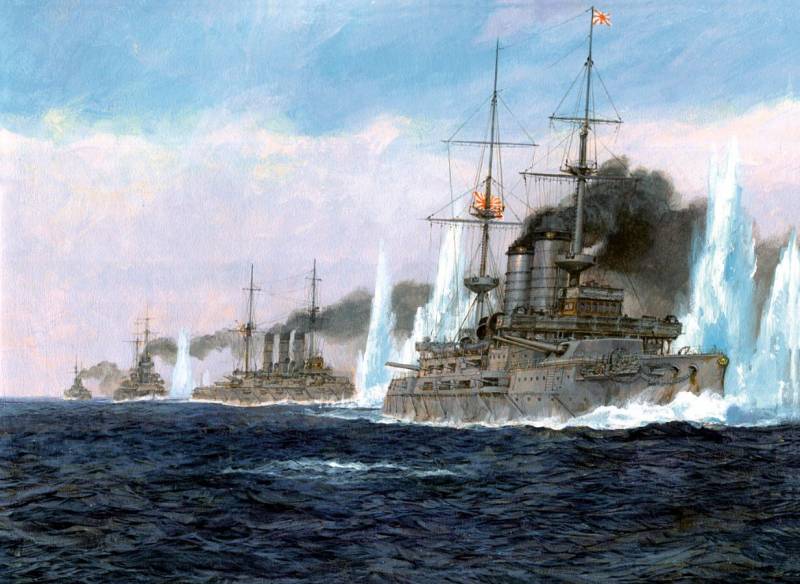
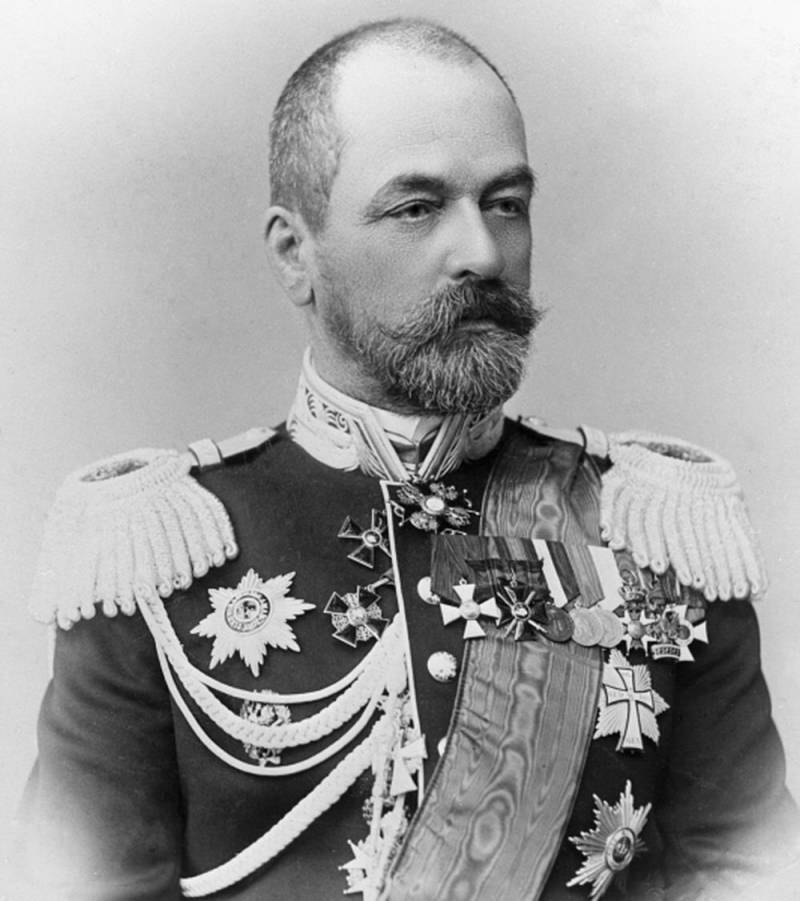
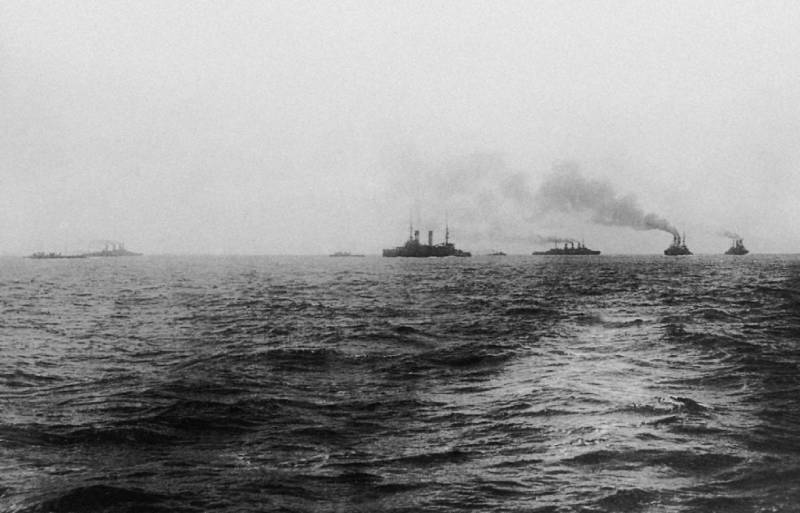
Information